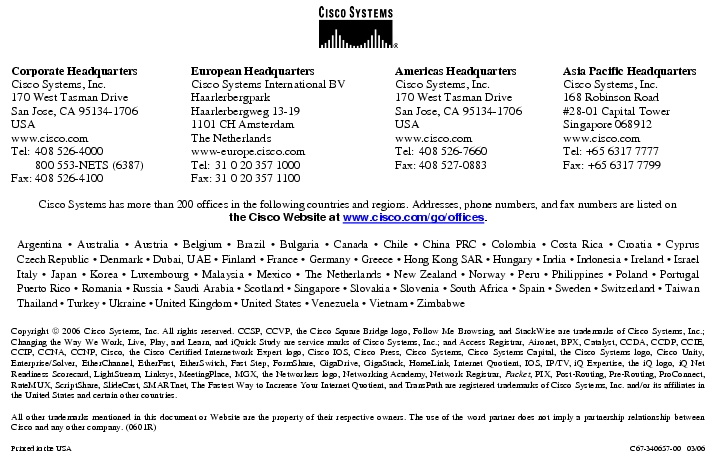Q&A
An Option for Resilient Services
Q. What is a Routed Access solution?
A. A Routed Access solution uses routing protocols in the wiring closet to increase network availability for real-time applications, decrease network complexity, and enable a standard set of configuration and troubleshooting tools for faster network implementation and more timely resolution to network issues. With intelligent and resilient Cisco® routing protocols such as Enhanced Interior Gateway Routing Protocol (EIGRP), routing in the access layer or wiring closet delivers the mechanisms that enable a network to recover from failure in a deterministic way without administrators having to fine-tune multiple protocols or devices. The unique EIGRP also delivers sub-200 millisecond (ms) convergence times with fewer configuration commands for an industry-leading routed access solution. The inherent deterministic recovery from failure helps ensure that your network remains available for your critical communication applications.
Q. Where do I implement a Routed Access solution?
A. A Routed Access solution is implemented in the wiring closet. By bringing intelligence and routing capabilities to the network edge, your network becomes more deterministic in the way it reacts after a network failover. This deterministic failover behavior is critical in order to support real-time applications such as voice over IP (VoIP), Instant Messaging (IM), and other collaborative applications where network availability is an essential requirement.
Q. Who benefits from using a Routed Access solution?
A. A Routed Access solution provides maximum benefits for enterprises seeking to either increase the availability of their network or decrease the complexity of their current network infrastructure. As real-time applications become more mainstream and enterprises expect their employees to be able to connect anywhere or anytime, the availability of the network becomes more critical than ever. Network availability can directly affect the profitability of an enterprise by providing the foundation for employees to be as productive and collaborative as possible. Reducing network complexity can allow IT teams to provide a higher level of service for users and focus on supporting new applications that can help grow the business.
Q. How does a Routed Access solution provide value?
A. By using one set of protocols for both the wiring closet and network core, the complexity of troubleshooting issues within the network is greatly reduced. Common tools used to troubleshoot network issues can be used across the entire network. Using fewer protocols reduces the margin of error in configuration and management.
Q. When is the best time to implement a Routed Access solution?
A. The best time to begin to design a Routed Access solution is before you start to implement real-time applications such as VoIP, IM, or other collaborative applications. There are a variety of Cisco Catalyst® switches that support EIGRP stub routing in the base version of software so you may already have the equipment necessary to migrate to a Routed Access solution in your network today. However, if you have already implemented real-time applications in your network and want to increase application availability, performance, and uptime, migrating to a Routed Access network is your logical next step. You can migrate at any time to achieve these benefits or to merely reduce the complexity of managing and maintaining your network.
Q. Is a Routed Access solution best for all networks?
A. A Routed Access solution may not be the best solution for all networks. However, for enterprises that use or plan to use real-time applications such as VoIP, IM, and desktop videoconferencing, a Routed Access solution can increase network availability. This can enhance the quality of the user experience by helping ensure that the applications and network are available when and where they are needed.
Q. What Cisco Catalyst switches can be used to provide Routed Access?
A. The Cisco Catalyst 3560, 3750, 4500, and 6500 Series can be used to implement a Routed Access solution. All of these switches can provide routing services for the wiring closet. In addition, the capability to operate as an EIGRP stub is included in the most basic level of software, so there are no extra costs associated with migrating to a Routed Access solution.
Q. Why should I implement a Routed Access solution?
A. The benefits of implementing a Routed Access solution include: increased network availability, decreased network complexity, ease of network troubleshooting, fewer resources spent on training, and fewer protocols within the network. All of these benefits directly relate to the operation and maintenance of a LAN. Increased network availability results from the network recovering from failures in a more deterministic way. The burden of troubleshooting is eased by the fact that Layer 3 protocols are now used throughout the network and only one command set needs to be utilized. Network administrators need only be fluent in Layer 3 protocols and commands, thereby greatly decreasing training time. Resources used to manage and maintain a network can sometimes be reduced as network outages decrease and troubleshooting is simplified.
Q. Do I need to reconfigure my entire network to use a Routed Access solution?
A. You do not need to reconfigure your entire network to implement a Routed Access solution. You are probably already running the routing protocols in the core of your network. A Routed Access solution uses the same routing protocols extended to the wiring closet. So by configuring your wiring closet switches to act as EIGRP or OSPF stub routers, you will have done most of the work toward implementing a Routed Access solution. EIGRP stub routing capability is built into the base image of the supporting Cisco Catalyst switches: the Catalyst 3560, 3750, 4500, and 6500 Series. The solution does require that VLANs remain local within a wiring closet.
TERMS
Table 1. Routed Access Solution: Terms and Definitions
FOR MORE INFORMATION
For more information about the Cisco Routed Access solution, visit http://www.cisco.com/go/resilientservices/ or contact your local account representative.
